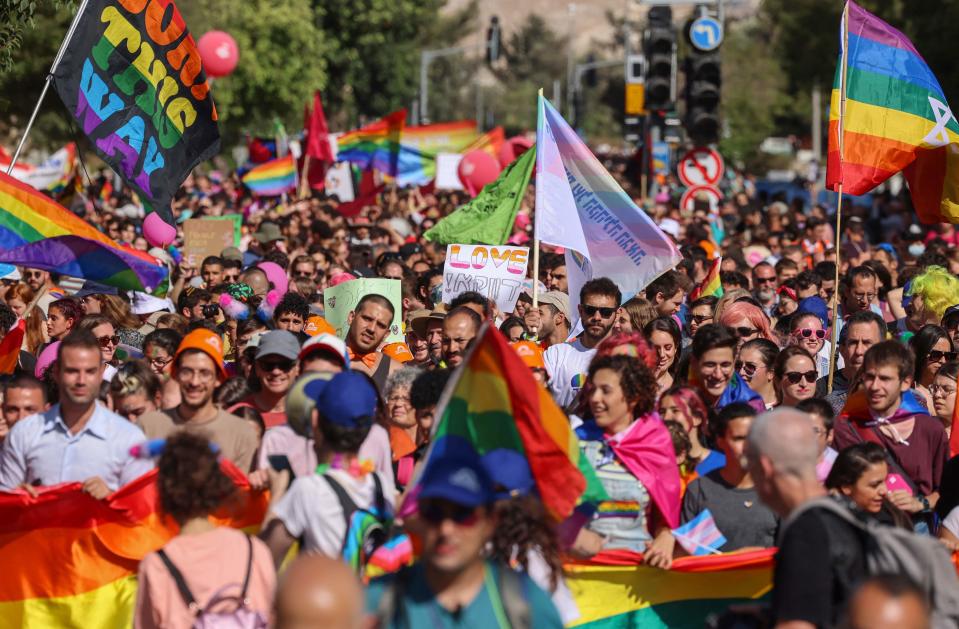What does the 'B' in LGBTQ stand for? Difference between bisexuality and pansexuality.
Millions of Americans identify as LGBTQ, and more than 20% of Gen Z are part of the LGBTQ community according to a 2024 Gallup poll.
More than half of LGBTQ Americans identify as bisexual, the largest category in the community. But even though 58% of the LGBTQ community is bisexual, they are far less likely to come out to family and friends than their gay and lesbian counterparts and may face discrimination even within the queer community.
Here's what to know about the community this Pride Month and beyond.

What does the ‘B’ in LGBTQ stand for?
The B in LGBTQ stands for bisexual. LGBTQ is an acronym of identities related to sexual orientation and gender identity.
What each letter in LGBTQ means:
L: Lesbian
G: Gay
B: Bisexual
T: Transgender
Q: Queer or questioning
In recent years, many have added I and A — intersex and asexual — to the lineup. The plus sign is often tacked onto the end to signal identities in the community that perhaps don’t fit into the other letters like pansexual, polyamorous, Two-Spirited or others who don’t label their sexuality.
Learn them all: Breaking down each letter in LGBTQ+
What does bisexual mean?
A bisexual person is someone who is attracted to more than one gender, but the term is often used to describe a wide spectrum of identities.
One of the most widely used definitions of bisexuality comes from activist and editor Robyn Ochs:
"I call myself bisexual because I acknowledge that I have in myself the potential to be attracted — romantically and/or sexually — to people of more than one sex and/or gender, not necessarily at the same time, not necessarily in the same way, and not necessarily to the same degree," Ochs says.
The term bi+ has also gained traction in recent years. Some use it as an umbrella term to describe people who experience any degree of attraction to more than one gender. This includes individuals who identify as pansexual, queer, omnisexual, fluid and more. The most important thing for many people identifying under the umbrella term bisexual or bi+ is that the label feels right for them. Not everyone is comfortable with or desires a label on their sexual and romantic attraction.
When was the word bisexual first used?
The first known use of the word bisexual dates to 1859 when anatomist Robert Bentley Todd used the term to describe what we now call intersex — the possession of male and female physical characteristics in the same body.
According to Stonewall, the word described a combination of masculine and feminine characteristics, now known as androgyny, at the turn of the 20th century. Only beginning in the 1910s was the word used to describe sexual and romantic attraction. In 1915, Sigmund Freud wrote about universal bisexuality as a combination of masculinity and femininity in gender and a more fluid sexual and romantic attraction.
What are the colors of the bisexual flag?
The colors of the bi pride flag are blue, pink and purple. The flag was created in 1998 by Michael Page, with pink representing attraction to the same sex, blue meaning attraction to the opposite sex and a purple stripe between the two signaling attraction to more than one.
What does pansexual mean?
While bisexual broadly describes attraction to more than one gender, pansexuality is attraction regardless of gender, but the two often overlap in ways that are nuanced and entirely personal to the individual.
One of the most well-known explanations of pansexuality is portrayed in sitcom Schitt’s Creek. In season 1, episode 10, David Rose and Stevie engage in a brief sexual relationship, surprising Stevie because she assumed David was gay.
“I only drink red wine,” Stevie says, referencing the fact that she is only attracted to men. “And up until last night I was under the impression that you too only drank red wine. But I guess I was wrong?”
“I do drink red wine, but I also drink white wine, and I’ve also been known to sample the occasional rosé,” David explains. “And a couple summers back I tried a Merlot that used to be a Chardonnay, which got a bit complicated … I like the wine and not the label, does that make sense?”
Whether you drink red wine, white wine, all wines or no wine at all, #SpiritDay celebrates you! Learn more at https://t.co/6F3XTJyQkg. pic.twitter.com/aPeRs7DNKu
— Schitt's Creek (Pop) (@SchittsCreekPop) October 15, 2020
‘Big Bisexual Book(s)': Why bi representation matters in fiction
Resources
If you're questioning your identity or looking for how best to support your LGBTQ loved ones, these resources can help. Find organizations with free education, crisis intervention, peer support and information below:
Trevor Project (Call 866-488-7386, Text 678-678): 24/7 year-round crisis intervention and suicide prevention services to lesbian, gay, bisexual, transgender and questioning (LGBTQ) young people ages 13-24.
Bisexual Resource Center: Community connection, free resources, definitions for bi+ community
PFLAG: 400+ chapters across the country providing confidential peer support, education, and advocacy to LGBTQ+ people, their parents and families, and allies.
Crisis Text Line (Text START to 741-741): Free, 24/7 support for those in crisis. Text from anywhere in the U.S. to connect with a trained Crisis Counselor.
The Gay, Lesbian, Bisexual and Transgender National Hotline: 888-843-4564
The GLBT National Youth Talkline (800-246-7743): Youth serving youth through age 25
Trans Lifeline: 877-565-8860
GLAAD: Education, awareness and resources
Just Curious for more? We've got you covered
USA TODAY is exploring the questions you and others ask every day. From "What does camp mean?" to "What color is a mirror?" to "How much do flight attendants make?", we're striving to find answers to the most common questions you ask every day. Head to our Just Curious section to see what else we can answer for you.
This article originally appeared on USA TODAY: What does bisexual mean? Learn about the 'B' in LGBTQ.


